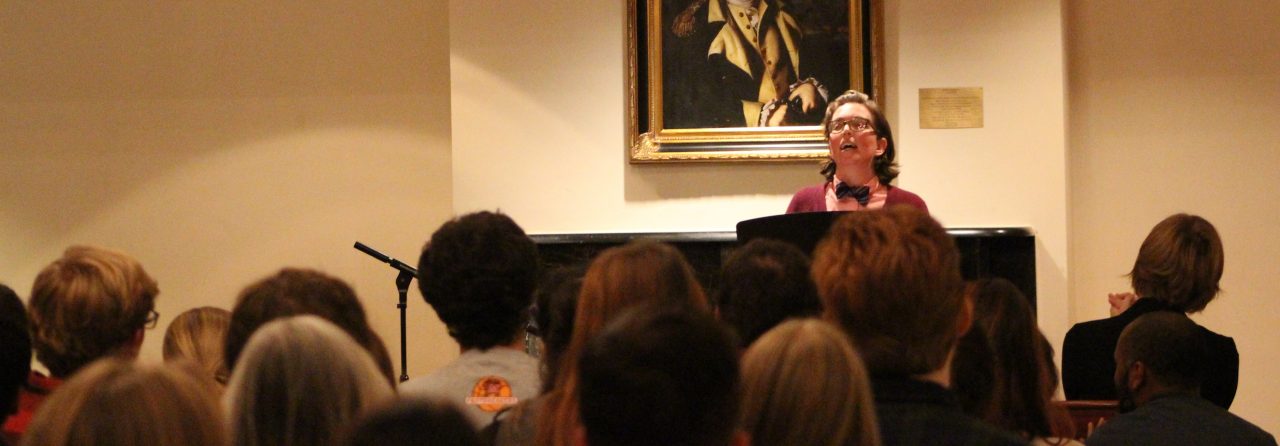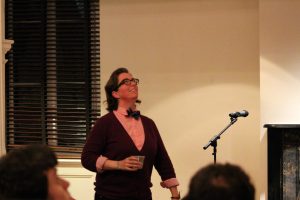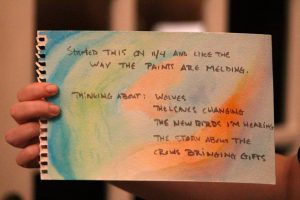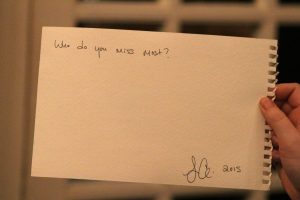
Crazyhorse Reading Series: Gabrielle Calvocoressi
November 17, 2015 | news, readings

We have a microphone, and we have a music stand, and we have Gabrielle Calvocoressi. “I have a really loud voice,” she says, testing the microphone. Her voice is indeed loud, not in a way that silences us, but a way that invites us in. She starts with a request. “I want to do something, see if you’d be in the mood for it.” In addition to reading from her two published books, she’s thinking of reading from the book she’s just finished, too. She lets us know that this idea scares her, but that she tries to do one thing a day she can fail at. “It would be an experiment,” she tells us excitedly, “and we’d all be in it together. Does that sound okay?” The unanimous response is yes. We dive in.

Her manner is hypnotizing. Poems weave into near-narratives; a stag often links them. Where does one end and the other begin? As we move to the Q&A, this spell does not break. Calvocoressi starts each exchange with “What’s your name” or “Hi, I’m Gabby! Nice to meet you,” turning each public question-and-answer into a personal encounter that, somehow, is communal as well.
One student asks about the watercolors Calvocoressi has placed on the table beside her. They have a story: she gets writer’s block, and was advised by author Lynda Barry to combat it with a kit of watercolors. Calvocoressi used them to paint lines that weren’t working in her poems, and now it’s a routine; she paints several times per day. When they began to pile up, she decided to put writing prompts on the back of them and give them out, for free, at her readings. Ideally, they might be shared between writers: “if you grab them, maybe you give them to someone else.”
Others ask about motifs in her poetry, like the reappearing stag. Calvocoressi grew up on a piece of land with deer and bucks all over, and deer imagery has been with her since. “How many of you have seen a buck?” she asks us. She describes the experience of looking through the leaves, seeing what looks like branches at first, maybe a tree, which then turns out to be a stag. She’s interested in the figure of the deer in literature, which makes even knights wonder. The deer, for her, represents “the timelessness of our awe.”
Others ask about craft. Though not a fiction writer, does she approach writing with a story in mind? She used to teach her students three things about poems: know who is speaking to whom, for what purpose, and from what mask. Then, she thought, “Why? Really, why?” Now she approaches her poetry as “a variously voiced tapestry” woven together by repetition and grounding. She thinks, “what are the kinds of repetition and kinds of grounding I can give the reader that makes them feel in the poems?” Repetition and grounding immerse the reader into the poem.

There’s more to talk about–that she writes poems in her head every day, that she does not use the word “revision” until the final edit, that she’s fascinated with hermits–but ultimately, we walked away understanding that immersion is important to Gabrielle Calvocoressi’s, which comes across in her poetry, and in her conversations with young writers and writing faculty alike.
